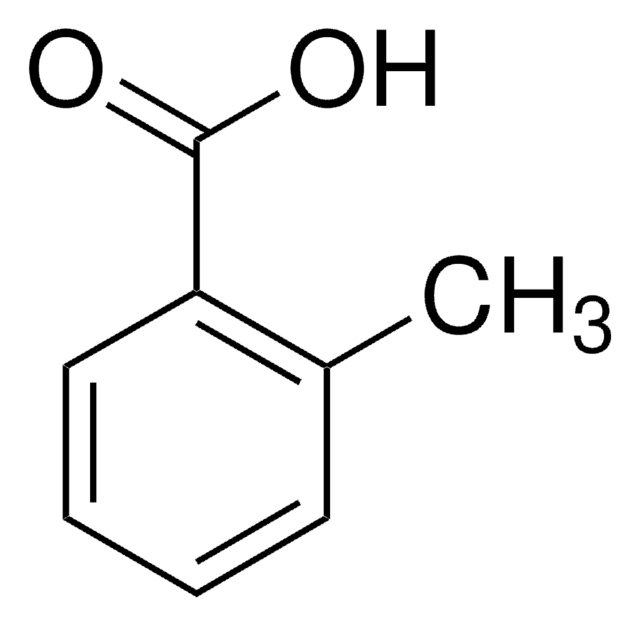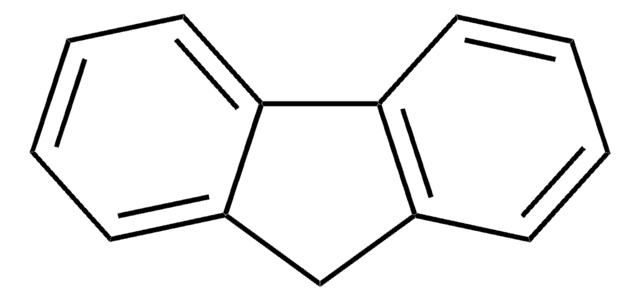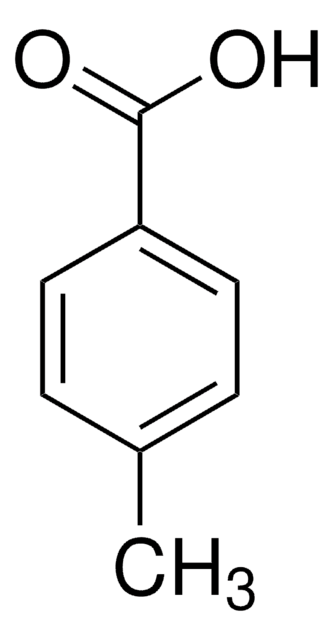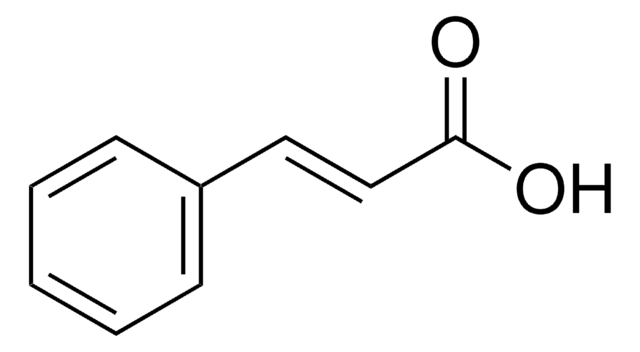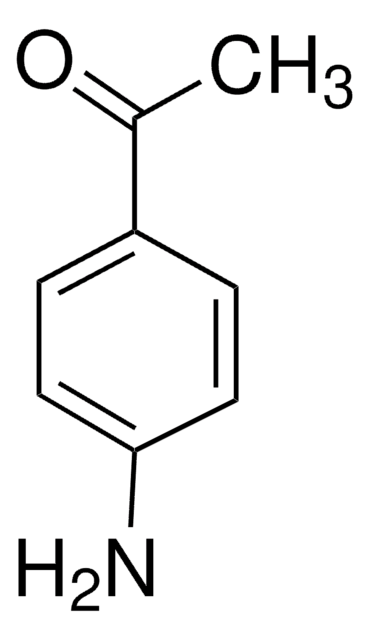Wszystkie zdjęcia(4)
Kluczowe dokumenty
T36609
m-Toluic acid
ReagentPlus®, 99%
Synonim(y):
3-Methylbenzoic acid
Zaloguj sięWyświetlanie cen organizacyjnych i kontraktowych
About This Item
Wzór liniowy:
CH3C6H4CO2H
Numer CAS:
Masa cząsteczkowa:
136.15
Beilstein:
970526
Numer WE:
Numer MDL:
Kod UNSPSC:
12352100
Identyfikator substancji w PubChem:
NACRES:
NA.22
Polecane produkty
Poziom jakości
linia produktu
ReagentPlus®
Próba
99%
bp
263 °C (lit.)
mp
107-113 °C (lit.)
gęstość
1.054 g/mL at 25 °C (lit.)
ciąg SMILES
Cc1cccc(c1)C(O)=O
InChI
1S/C8H8O2/c1-6-3-2-4-7(5-6)8(9)10/h2-5H,1H3,(H,9,10)
Klucz InChI
GPSDUZXPYCFOSQ-UHFFFAOYSA-N
Szukasz podobnych produktów? Odwiedź Przewodnik dotyczący porównywania produktów
Informacje prawne
ReagentPlus is a registered trademark of Merck KGaA, Darmstadt, Germany
Ta strona może zawierać tekst przetłumaczony maszynowo.
Hasło ostrzegawcze
Warning
Zwroty wskazujące rodzaj zagrożenia
Zwroty wskazujące środki ostrożności
Klasyfikacja zagrożeń
Eye Irrit. 2
Kod klasy składowania
11 - Combustible Solids
Klasa zagrożenia wodnego (WGK)
WGK 3
Temperatura zapłonu (°F)
302.0 °F
Temperatura zapłonu (°C)
150 °C
Środki ochrony indywidualnej
dust mask type N95 (US), Eyeshields, Gloves
Wybierz jedną z najnowszych wersji:
Masz już ten produkt?
Dokumenty związane z niedawno zakupionymi produktami zostały zamieszczone w Bibliotece dokumentów.
Klienci oglądali również te produkty
Jun Yao et al.
Applied and environmental microbiology, 73(8), 2735-2743 (2007-02-27)
Mobile group II introns ("targetrons") can be programmed for insertion into virtually any desired DNA target with high frequency and specificity. Here, we show that targetrons expressed via an m-toluic acid-inducible promoter from a broad-host-range vector containing an RK2 minireplicon
Rafael Silva-Rocha et al.
Molecular bioSystems, 8(7), 1950-1957 (2012-05-17)
In this report, we experimentally demonstrate that improving the cis-regulatory region of a target promoter can significantly enhance the response to an otherwise poor inducer. The transcriptional factor (TF) BenR of Pseudomonas putida KT2440 is a member of the AraC/XylS
G M Stephens et al.
Journal of general microbiology, 133(7), 1891-1899 (1987-07-01)
The effect of various lipophilic weak acids on the stability of certain TOL plasmids was investigated. Benzoate induced deletion of TOL plasmid DNA in Pseudomonas putida MT15, followed by loss of the plasmid; this effect was pH- and concentration-dependent, suggesting
R J Kolenc et al.
Applied and environmental microbiology, 54(3), 638-641 (1988-03-01)
A psychrotrophic bacterium, originally isolated from a natural aquatic environment, was characterized and identified as Pseudomonas putida Q5 for use as a representative recipient for biodegradative genes from a mesophilic microorganism. The TOL plasmid pWWO of the mesophile P. putida
Minna M Jussila et al.
Environmental pollution (Barking, Essex : 1987), 139(2), 244-257 (2005-08-02)
A collection of 50 indigenous meta-toluate tolerating bacteria isolated from oil-contaminated rhizosphere of Galega orientalis on selective medium was characterized and identified by classical and molecular methods. 16S rDNA partial sequencing showed the presence of five major lineages of the
Nasz zespół naukowców ma doświadczenie we wszystkich obszarach badań, w tym w naukach przyrodniczych, materiałoznawstwie, syntezie chemicznej, chromatografii, analityce i wielu innych dziedzinach.
Skontaktuj się z zespołem ds. pomocy technicznej